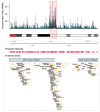Exploration of fine-scale recombination rate variation in the domestic horse
- PMID: 31434677
- PMCID: PMC6771410
- DOI: 10.1101/gr.243311.118
Exploration of fine-scale recombination rate variation in the domestic horse
Abstract
Total genetic map length and local recombination landscapes typically vary within and across populations. As a first step to understanding the recombination landscape in the domestic horse, we calculated population recombination rates and identified likely recombination hotspots using approximately 1.8 million SNP genotypes for 485 horses from 32 distinct breeds. The resulting breed-averaged recombination map spans 2.36 Gb and accounts for 2939.07 cM. Recombination hotspots occur once per 23.8 Mb on average and account for ∼9% of the physical map length. Regions with elevated recombination rates in the entire cohort were enriched for genes in pathways involving interaction with the environment: immune system processes (specifically, MHC class I and class II genes), responses to stimuli, and serotonin receptor pathways. We found significant correlations between differences in local recombination rates and population differentiation quantified by F ST Analysis of breed-specific maps revealed thousands of hotspot regions unique to particular breeds, as well as unique "coldspots," regions where a particular breed showed below-average recombination, whereas all other breeds had evidence of a hotspot. Finally, we identified relative enrichment (P = 5.88 × 10-27) for the in silico-predicted recognition motif for equine PR/SET domain 9 (PRDM9) in recombination hotspots. These results indicate that selective pressures and PRDM9 function contribute to variation in recombination rates across the domestic horse genome.
© 2019 Beeson et al.; Published by Cold Spring Harbor Laboratory Press.
Figures




References
-
- Auton A, Myers S, McVean G. 2014. Identifying recombination hotspots using population genetic data. arXiv:1403.4264 [q-bio.QM].
Publication types
MeSH terms
Grants and funding
LinkOut - more resources
Full Text Sources
Research Materials
Miscellaneous
